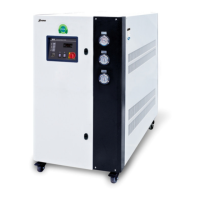36(45)
5. Troubleshooting
Faults
The Action of
the Protection
Units
The Possible Fault Analysis Solutions
1. No power
display or
phase reverse
The protective
device can’t work
A. Power is not on.
B. The control circuit fused
C. The phase sequence of
power line is reversed
D. The main power or circuit
failure.
A. Check before power is on
B. Check the protection loop.
C. Replace any two of the
power incoming wires.
D. Check or replace.
2. Pump
overload
Loader trips
A. High transient current
B. Pump failure
C. Pump loader failure
A. Reset the loader.
B. Repair or replace
C. Repair or replace
3.Compressor
overload
Loader trips
A. High transient current
B. Compressor failure
C. Compressor loader failure
A. Reset the loader
B. Repair and replace
C. Repair and replace
4. Over high-
pressure
High-pressure
switch trips
A. Too much refrigerant
B. Insufficient condenser
C. air output
D. Too much water scalein the
condenser
E. Drying filter blocked
F. The opening of the expansion
valve is too small
G. Expansion valve fault
H. Fan fault
I. High-pressure switch failure
A. Discharge part of
B. the refrigerant
C. Increase the air volume.
D. Clean the condenser.
E. Clean the drying filter.
F. Adjust the opening properly.
G. Repair and replace
H. Repair and replace
I. Repair and replace
5.Low
high-pressure
Protective device
no action
A. Insufficient cooling
B. The compressor valve plate
is damaged.
C. The cooling water flow is too
large.
A. Increase the refrigerant
B. Repair and replace
C.Regulate the water valve
flow.
6.Low
low-pressure
Low-pressure
swtich trips
A. Insufficient refrigerant
B. Drying filter blocked.
C. The opening of the
expansion valve is too small.
D. Expansion valve fault.
E. Low pressure switch fault.
F. Poor evaporator heat
exchange
G. Low system load
A. Check the system pipe,
weld the pipe and refill the
refrigerant.
B. Clean the drying filter.
C. Adjust the opening properly.
D. Repair and replace
E. Repair and replace
F. Clean the evaporator
G. G. Increase the load.
7. Low
high-pressure
Protective device
no action
A. The cooling load is too large.
B. Low compressor ability
C. The opening of the
expansion valve is too large.
D. Too much of the refrigerant
A. Adjust the load
B. Repair and replace
C. Adjust
D. Discharge part
E. of the refrigerant.

